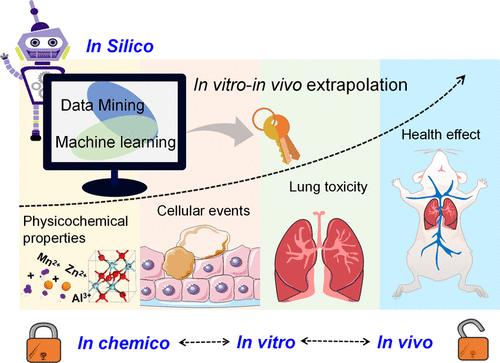In Vitro-to-In Vivo Extrapolation on Lung Toxicity Induced by Metal Oxide Nanoparticles via Data-Mining
IF 11.3
1区 环境科学与生态学
Q1 ENGINEERING, ENVIRONMENTAL
引用次数: 0
Abstract
While in silico analyses are commonly employed for chemical risk assessments, predicting chronic lung toxicity induced by engineered nanoparticles (ENMs) in vivo still faces many challenges due to complex interactions at multiple nanobio interfaces. In this study, we developed a rigorous method to compile published evidence on the in vivo lung toxicity of metal oxide nanoparticles (MeONPs) and revealed previously overlooked in vitro-to-in vivo extrapolation (IVIVE) relationships. A comprehensive multidimensional data set containing 1102 in vivo data points, 75 pulmonary toxicological biomarkers, and 20 features (covering in vitro effects, physicochemical properties, and exposure conditions) was constructed. An IVIVE approach that related effects at the cellular level to in vivo lung toxicity in rodent model was established with prediction accuracy reaching 89 and 80% in training and test sets. Experimental validation was conducted by testing chronic lung fibrosis of 8 new MeONPs in 32 independent mice, with prediction accuracy reaching 88%. The IVIVE model indicated that the proinflammatory cytokine IL-1β in THP-1 cells could serve as an in vitro marker to predict lung toxicity. The IVIVE model showed great promise for minimizing unnecessary animal tests and understanding toxicological mechanisms.

基于数据挖掘的金属氧化物纳米颗粒肺毒性体外-体内外推
虽然硅分析通常用于化学风险评估,但由于多个纳米生物界面的复杂相互作用,预测工程纳米颗粒(ENMs)在体内诱导的慢性肺毒性仍然面临许多挑战。在这项研究中,我们开发了一种严格的方法来汇编已发表的关于金属氧化物纳米颗粒(MeONPs)体内肺毒性的证据,并揭示了以前被忽视的体外-体内外推(IVIVE)关系。构建了一个包含1102个体内数据点、75个肺毒理学生物标志物和20个特征(包括体外效应、理化性质和暴露条件)的综合多维数据集。建立了一种将细胞水平影响与啮齿动物模型体内肺毒性联系起来的IVIVE方法,在训练集和测试集的预测准确率分别达到89%和80%。通过在32只独立小鼠中检测8种新MeONPs的慢性肺纤维化进行实验验证,预测准确率达到88%。IVIVE模型显示THP-1细胞中的促炎细胞因子IL-1β可作为预测肺毒性的体外标志物。IVIVE模型在减少不必要的动物试验和了解毒理学机制方面显示出很大的希望。
本文章由计算机程序翻译,如有差异,请以英文原文为准。
求助全文
约1分钟内获得全文
求助全文
来源期刊

环境科学与技术
环境科学-工程:环境
CiteScore
17.50
自引率
9.60%
发文量
12359
审稿时长
2.8 months
期刊介绍:
Environmental Science & Technology (ES&T) is a co-sponsored academic and technical magazine by the Hubei Provincial Environmental Protection Bureau and the Hubei Provincial Academy of Environmental Sciences.
Environmental Science & Technology (ES&T) holds the status of Chinese core journals, scientific papers source journals of China, Chinese Science Citation Database source journals, and Chinese Academic Journal Comprehensive Evaluation Database source journals. This publication focuses on the academic field of environmental protection, featuring articles related to environmental protection and technical advancements.
 求助内容:
求助内容: 应助结果提醒方式:
应助结果提醒方式:


